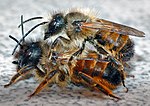Placozoa
| Placozoa | |
|---|---|
| Thời điểm hóa thạch: 635–542 triệu năm trước đây[1] Cũng có thể tiến hóa vào khoảng 720-635 triệu năm trước.[1] | |
 | |
| Phân loại khoa học | |
| Vực (domain) | Eukaryota |
| Giới (regnum) | Animalia |
| Phân giới (subregnum) | Parazoa |
| Ngành (phylum) | Placozoa |
Grell, 1971 | |
| Các lớp[2] | |
| |
Placozoa (/plækəˈzoʊə/) là một dạng cơ bản động vật không xương sống.[3] Chúng là những cấu trúc đơn giản nhất trong tất cả các động vật đa bào không ký sinh (Metazoa), được phân vào phân giới Parazoa một số tài liệu đặt chúng vào phân giới Agnothozoa. Chúng được phân loại là có 3 loài duy nhất, Trichoplax adhaerens, Hoilungia hongkongensis và Polyplacotoma mediterranea, mặc dù có đủ sự đa dạng di truyền có khả năng là có nhiều loài có hình thái tương tự.[4] Lần đầu tiên được phát hiện vào năm 1883 bởi các nhà động vật học người Đức, Franz Eilhard Schulze (1840-1921)[5] và từ những năm 1970 có hệ thống hơn, phân tích bởi nhà vi sinh vật học người Đức, Karl Gottlieb Grell (1912-1994),[6] một tên thông thường cho đơn vị phân loại chưa tồn tại, tên khoa học theo nghĩa đen có nghĩa là "động vật phẳng".[7]
Placozoa chỉ có bốn loại tế bào nên cơ thể rất đơn giản có hình một cái đĩa nhỏ. Dù vậy, đó vẫn là một cơ thể thực thụ.
Một số tế bào ở mặt dưới được chuyên hóa cho chức năng tiêu hóa; số khác có roi giúp cho sinh vật di chuyển. Có ít thông tin về thức ăn của chúng trong môi trường hoang dã, nơi chúng sống hoặc sinh cảnh tự nhiên của chúng.
Phân loại học
Ngành Placozoa được chia thành một họ là Trichoplacidae (đặt tên bởi Bütschli & Hatschek vào năm 1905). Loài đầu tiên được tìm thấy tại một bể cá nước biển ở Viện Động vật học ở Graz, Áo. Là loài Trichoplax adhaerens đặt tên bởi Franz Eilhard Schulze vào năm 1883 .[8] Chúng có tên đồng nghĩa là Trichoplax reptans.
Hoilungia hongkongensis và Polyplacotoma mediterranea là 2 loài cuối cùng được tìm thấy vào năm 2017.[9][10][11][12][13]
Xem thêm
Tham khảo
- ^ a b “Science Direct:Placozoan” (bằng tiếng Anh).
- ^ Tessler, Michael; Neumann, Johannes S.; Kamm, Kai; Osigus, Hans-Jürgen; Eshel, Gil; Narechania, Apurva; Burns, John A.; DeSalle, Rob; Schierwater, Bernd (8 tháng 12 năm 2022). “Phylogenomics and the first higher taxonomy of Placozoa, an ancient and enigmatic animal phylum”. Frontiers in Ecology and Evolution. 10. doi:10.3389/fevo.2022.1016357.
- ^ MeSH Placozoa
- ^ O Voigt & Collins AG, Pearse VB, Pearse JS, Hadrys H, Ender A (2004). al.Current.Biology.2004.pdf “Placozoa — no longer a phylum of one” Kiểm tra giá trị
|url=(trợ giúp) (PDF). Current Biology. 14 (22): R944–5. doi:10.1016/j.cub.2004.10.036. PMID 15556848.Quản lý CS1: sử dụng tham số tác giả (liên kết)[liên kết hỏng] - ^ F. E. Schulze "Trichoplax adhaerens n. g., n. s.", Zoologischer Anzeiger (Elsevier, Amsterdam and Jena) 6 (1883), p. 92.
- ^ K. G. Grell: "Trichoplax adhaerens, F. E. Schulze und die Entstehung der Metazoen", Naturwissenschaftliche Rundschau, 24 (1971), p. 160.
- ^ Rüdiger Wehner & Walter Gehring (tháng 6 năm 2007). Zoologie (bằng tiếng Đức) (ấn bản 24). Stuttgart: Thieme. tr. 696.
- ^ M. Eitel (2011). B. Schierwater, M. Eitel & R. DeSalle (biên tập). “Trichoplax Schulze, 1883”. World Placozoa Database. Cơ sở dữ liệu sinh vật biển.
- ^ Voigt, O; Collins AG; Pearse VB; Pearse JS; Hadrys H; Ender A (23 tháng 11 năm 2004). “Placozoa — no longer a phylum of one”. Current Biology. 14 (22): R944–5. doi:10.1016/j.cub.2004.10.036. PMID 15556848. S2CID 11539852.
- ^ Eitel, Michael; Osigus, Hans-Jürgen; DeSalle, Rob; Schierwater, Bernd (2 tháng 4 năm 2013). “Global Diversity of the Placozoa”. PLOS ONE. 8 (4): e57131. Bibcode:2013PLoSO...857131E. doi:10.1371/journal.pone.0057131. PMC 3614897. PMID 23565136.
- ^ Eitel, Michael; Francis, Warren; Osigus, Hans-Jürgen; Krebs, Stefan; Vargas, Sergio; Blum, Helmut; Williams, Gray Argust; Schierwater, Bernd; Wörheide, Gert (13 tháng 10 năm 2017). “A taxogenomics approach uncovers a new genus in the phylum Placozoa”. bioRxiv (bằng tiếng Anh): 202119. doi:10.1101/202119.
- ^ Francis, Warren R.; Wörheide, Gert (1 tháng 6 năm 2017). “Similar Ratios of Introns to Intergenic Sequence across Animal Genomes”. Genome Biology and Evolution (bằng tiếng Anh). 9 (6): 1582–1598. doi:10.1093/gbe/evx103. PMC 5534336. PMID 28633296.
- ^ Schierwater, Bernd; Kamm, Kai; Herzog, Rebecca; Rolfes, Sarah; Osigus, Hans-Jürgen (4 tháng 3 năm 2019). “Polyplacotoma mediterranea is a new ramified placozoan species”. Current Biology (bằng tiếng Anh). 29 (5): R148–R149. doi:10.1016/j.cub.2019.01.068. ISSN 0960-9822. PMID 30836080.
Liên kết ngoài
- The Trichoplax adhaerens Grell-BS-1999 v1.0 Genome Portal at the DOE Joint Genome Institute
- The Trichoplax Genome Project at the Yale Peabody Museum
- A Weird Wee Beastie: Trichoplax adhaerens
- Research articles from the ITZ, TiHo Hannover
- Information page from the University of California at Berkeley
- Ender A, Schierwater B (2003). “Placozoa are not derived cnidarians: evidence from molecular morphology”. Mol. Biol. Evol. 20 (1): 130–4. doi:10.1093/molbev/msg018. PMID 12519915. - Mitochondrial DNA và 16S rRNA analysis and phylogeny of Trichoplax adhaerens
- Historical overview of Trichoplax research Lưu trữ 2007-09-27 tại Wayback Machine
- Science Daily:Genome Of Simplest Animal Reveals Ancient Lineage, Confounding Array Of Complex Capabilities
- Vicki Buchsbaum Pearse, and Oliver Voigt, 2007. Field biology of placozoans (Trichoplax): distribution, diversity, biotic interactions. Integrative and Comparative Biology, doi:10.1093/icb/icm015.


















